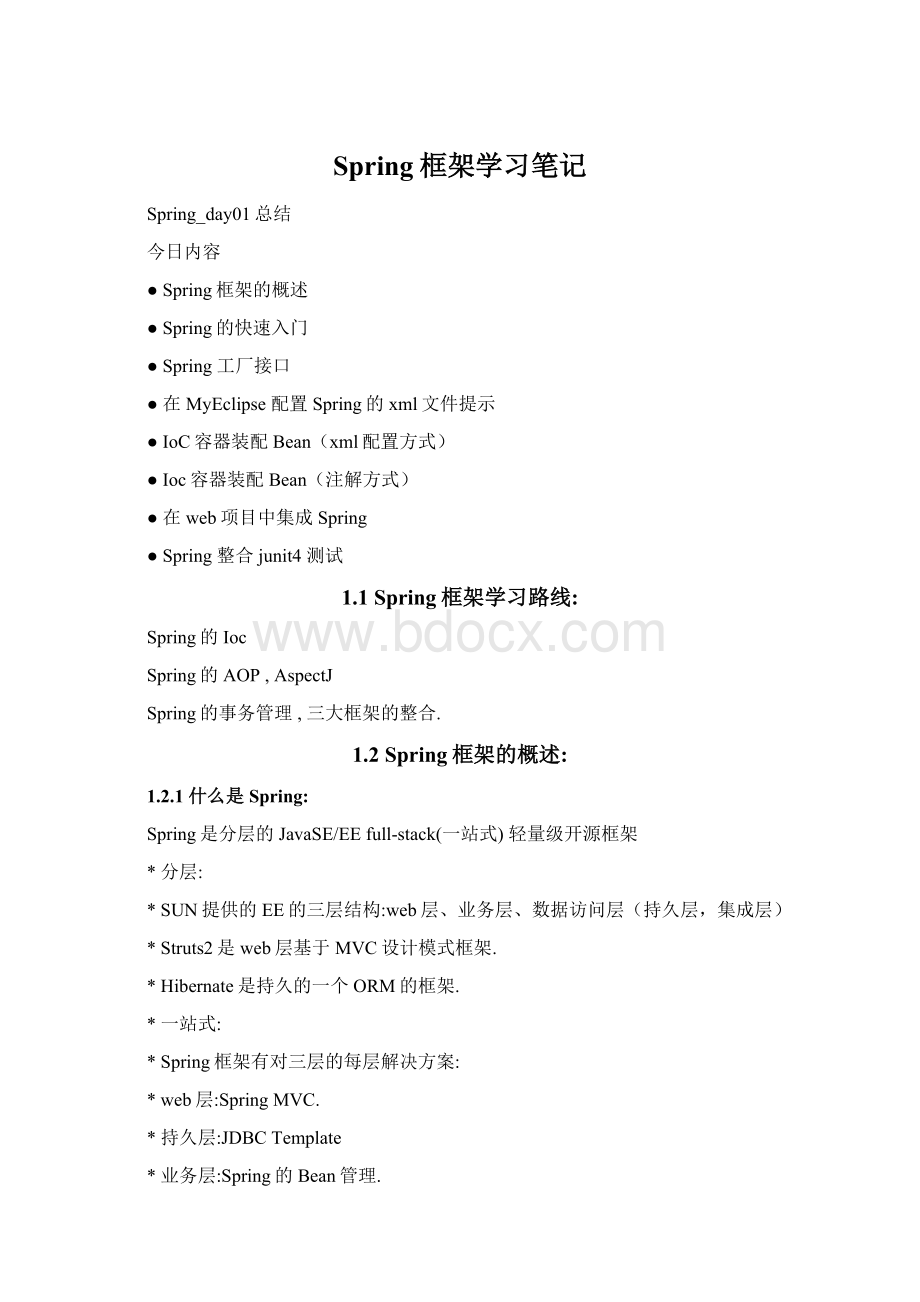Spring框架学习笔记.docx
《Spring框架学习笔记.docx》由会员分享,可在线阅读,更多相关《Spring框架学习笔记.docx(14页珍藏版)》请在冰豆网上搜索。

Spring框架学习笔记
Spring_day01总结
今日内容
●Spring框架的概述
●Spring的快速入门
●Spring工厂接口
●在MyEclipse配置Spring的xml文件提示
●IoC容器装配Bean(xml配置方式)
●Ioc容器装配Bean(注解方式)
●在web项目中集成Spring
●Spring整合junit4测试
1.1Spring框架学习路线:
Spring的Ioc
Spring的AOP,AspectJ
Spring的事务管理,三大框架的整合.
1.2Spring框架的概述:
1.2.1什么是Spring:
Spring是分层的JavaSE/EEfull-stack(一站式)轻量级开源框架
*分层:
*SUN提供的EE的三层结构:
web层、业务层、数据访问层(持久层,集成层)
*Struts2是web层基于MVC设计模式框架.
*Hibernate是持久的一个ORM的框架.
*一站式:
*Spring框架有对三层的每层解决方案:
*web层:
SpringMVC.
*持久层:
JDBCTemplate
*业务层:
Spring的Bean管理.
1.2.2Spring的核心:
IOC:
(InverseofControl反转控制)
*控制反转:
将对象的创建权,交由Spring完成.
AOP:
AspectOrientedProgramming是面向对象的功能延伸.不是替换面向对象,是用来解决OO中一些问题.
IOC:
控制反转.
1.2.3Spring的版本:
Spring3.x和Spring4.xSpring4需要整合hibernate4.
1.2.4EJB:
企业级JavaBean
EJB:
SUN公司提出EE解决方案.
2002:
ExpertOne-to-OneJ2EEDesignandDevelopment
2004:
ExpertOne-to-OneJ2EEDevelopmentwithoutEJB(EE开发真正需要使用的内容.)
1.2.5Spring优点:
方便解耦,简化开发
*Spring就是一个大工厂,可以将所有对象创建和依赖关系维护,交给Spring管理
AOP编程的支持
*Spring提供面向切面编程,可以方便的实现对程序进行权限拦截、运行监控等功能
声明式事务的支持
*只需要通过配置就可以完成对事务的管理,而无需手动编程
方便程序的测试
*Spring对Junit4支持,可以通过注解方便的测试Spring程序
方便集成各种优秀框架
*Spring不排斥各种优秀的开源框架,其内部提供了对各种优秀框架(如:
Struts、Hibernate、MyBatis、Quartz等)的直接支持
降低JavaEEAPI的使用难度
*Spring对JavaEE开发中非常难用的一些API(JDBC、JavaMail、远程调用等),都提供了封装,使这些API应用难度大大降低
1.3Spring的入门的程序:
1.3.1下载Spring的开发包:
spring-framework-3.2.0.RELEASE-dist.zip---Spring开发包
*docs:
spring框架api和规范
*libs:
spring开发的jar包
*schema:
XML的约束文档.
spring-framework-3.0.2.RELEASE-dependencies.zip---Spring开发中的依赖包
1.3.2创建web工程引入相应jar包:
spring-beans-3.2.0.RELEASE.jar
spring-context-3.2.0.RELEASE.jar
spring-core-3.2.0.RELEASE.jar
spring-expression-3.2.0.RELEASE.jar
开发的日志记录的包:
mons.logging-1.1.1.jar---用于整合其他的日志的包(类似Hibernate中slf4j)
com.springsource.org.apache.log4j-1.2.15.jar
1.3.3创建Spring的配置文件:
在src下创建一个applicationContext.xml
引入XML的约束:
*找到xsd-config.html.引入beans约束:
//www.springframework.org/schema/beans"
xmlns:
xsi="http:
//www.w3.org/2001/XMLSchema-instance"
xsi:
schemaLocation="
http:
//www.springframework.org/schema/beanshttp:
//www.springframework.org/schema/beans/spring-beans.xsd">
1.3.4在配置中配置类:
1.3.5创建测试类:
@Test
//Spring开发
publicvoiddemo2(){
//创建一个工厂类.
ApplicationContextapplicationContext=newClassPathXmlApplicationContext(
"applicationContext.xml");
HelloServicehelloService=(HelloService)applicationContext.getBean("userService");
helloService.sayHello();
}
1.3.6IOC和DI(*****)区别?
IOC:
控制反转:
将对象的创建权,由Spring管理.
DI:
依赖注入:
在Spring创建对象的过程中,把对象依赖的属性注入到类中.
*面向对象中对象之间的关系;
*依赖:
publicclassA{
privateBb;
}
*继承:
isa
*聚合:
*聚集:
*组合:
1.3.7Spring框架加载配置文件:
ApplicationContext应用上下文,加载Spring框架配置文件
加载classpath:
newClassPathXmlApplicationContext("applicationContext.xml");:
加载classpath下面配置文件.
加载磁盘路径:
newFileSystemXmlApplicationContext("applicationContext.xml");:
加载磁盘下配置文件.
1.3.8BeanFactory与ApplicationContext区别?
ApplicationContext类继承了BeanFactory.
BeanFactory在使用到这个类的时候,getBean()方法的时候才会加载这个类.
ApplicationContext类加载配置文件的时候,创建所有的类.
ApplicationContext对BeanFactory提供了扩展:
*国际化处理
*事件传递
*Bean自动装配
*各种不同应用层的Context实现
*****早期开发使用BeanFactory.
1.3.9MyEclipse配置XML提示:
Window--->xmlcatalog--->add找到schema的位置,将复制的路径copy指定位置,选择schemalocation.
1.4IOC装配Bean:
1.4.1Spring框架Bean实例化的方式:
提供了三种方式实例化Bean.
*构造方法实例化:
(默认无参数)
*静态工厂实例化:
*实例工厂实例化:
无参数构造方法的实例化:
--默认情况下使用的就是无参数的构造方法.-->
静态工厂实例化:
--第二种使用静态工厂实例化-->
实例工厂实例化:
--第三种使用实例工厂实例化-->
1.4.2Bean的其他配置:
id和name的区别:
id遵守XML约束的id的约束.id约束保证这个属性的值是唯一的,而且必须以字母开始,可以使用字母、数字、连字符、下划线、句话、冒号
name没有这些要求
*****如果bean标签上没有配置id,那么name可以作为id.
*****开发中Spring和Struts1整合的时候,/login.
现在的开发中都使用id属性即可.
类的作用范围:
scope属性:
*singleton:
单例的.(默认的值.)
*prototype:
多例的.
*request:
web开发中.创建了一个对象,将这个对象存入request范围,request.setAttribute();
*session:
web开发中.创建了一个对象,将这个对象存入session范围,session.setAttribute();
*globalSession:
一般用于Porlet应用环境.指的是分布式开发.不是porlet环境,globalSession等同于session;
实际开发中主要使用singleton,prototype
Bean的生命周期:
配置Bean的初始化和销毁的方法:
配置初始化和销毁的方法:
*init-method=”setup”
*destroy-method=”teardown”
执行销毁的时候,必须手动关闭工厂,而且只对scope=”singleton”有效.
Bean的生命周期的11个步骤:
1.instantiatebean对象实例化
2.populateproperties封装属性
3.如果Bean实现BeanNameAware执行setBeanName
4.如果Bean实现BeanFactoryAware或者ApplicationContextAware设置工厂setBeanFactory或者上下文对象setApplicationContext
5.如果存在类实现BeanPostProcessor(后处理Bean),执行postProcessBeforeInitialization
6.如果Bean实现InitializingBean执行afterPropertiesSet
7.调用指定初始化方法init
8.如果存在类实现BeanPostProcessor(处理Bean),执行postProcessAfterInitialization
9.执行业务处理
10.如果Bean实现DisposableBean执行destroy
11.调用指定销毁方法customerDestroy
在CustomerService类的add方法之前进行权限校验?
1.4.3Bean中属性注入:
Spring支持构造方法注入和setter方法注入:
构造器注入:
--
-->
setter方法注入:
--标签中name就是属性名称,value是普通属性的值,ref:
引用其他的对象-->
setter方法注入对象属性:
名称空间p:
注入属性:
Spring2.5版本引入了名称空间p.
p:
<属性名>="xxx"引入常量值
p:
<属性名>-ref="xxx"引用其它Bean对象
引入名称空间:
//www.springframework.org/schema/beans"
xmlns:
p="http:
//www.springframework.org/schema/p"
xmlns:
xsi="http:
//www.w3.org/2001/XMLSchema-instance"
xsi:
schemaLocation="
http:
//www.springframework.org/schema/beanshttp:
//www.springframework.org/schema/beans/spring-beans.xsd">
name="宝马"p:
price="400000"/>
name="童童"p:
car2-ref="car2"/>
SpEL:
属性的注入:
Spring3.0提供注入属性方式:
语法:
#{表达式}
---->
1.4.4集合属性的注入:
--注入List集合-->
童童
小凤
--注入set集合-->
杜宏
如花
--注入map集合-->
root
123
1.4.5加载配置文件:
一种写法:
ApplicationContextapplicationContext=newClassPathXmlApplicationContext("bean1.xml",”bean2.xml”);
二种方法:
1.5IOC装配Bean(注解方式)
1.5.1Spring的注解装配Bean
Spring2.5引入使用注解去定义Bean
@Component描述Spring框架中Bean
Spring的框架中提供了与@Component注解等效的三个注解:
@Repository用于对DAO实现类进行标注
@Service用于对Service实现类进行标注
@Controller用于对Controller实现类进行标注
*****三个注解为了后续版本进行增强的.
1.5.2Bean的属性注入:
普通属性;
@Value(value="itcast")
privateStringinfo;
对象属性:
@Autowired:
自动装配默认使用类型注入.
@Autowired
@Qualifier("userDao")---按名称进行注入.
@Autowired
@Qualifier("userDao")
privateUserDaouserDao;
等价于
@Resource(name="userDao")
privateUserDaouserDao;
1.5.3Bean其他的属性的配置:
配置Bean初始化方法和销毁方法:
*init-method和destroy-method.
@PostConstruct初始化
@PreDestroy销毁
配置Bean的作用范围:
@Scope
1.5.4Spring3.0提供使用Java类定义Bean信息的方法
@Configuration
publicclassBeanConfig{
@Bean(name="car")
publicCarshowCar(){
Carcar=newCar();
car.setName("长安");
car.setPrice(40000d);
returncar;
}
@Bean(name="product")
publicProductinitProduct(){
Productproduct=newProduct();
product.setName("空调");
product.setPrice(3000d);
returnproduct;
}
}
1.5.5实际开发中使用XML还是注解?
XML:
*bean管理
注解;
*注入属性的时候比较方便.
两种方式结合;一般使用XML注册Bean,使用注解进行属性的注入.
annotation-config/>
s
@Autowired
@Qualifier("orderDao")
privateOrderDaoorderDao;
1.6Spring整合web开发:
正常整合Servlet和Spring没有问题的
但是每次执行Servlet的时候加载Spring配置,加载Spring环境.
*解决办法:
在Servlet的init方法中加载Spring配置文件?
*当前这个Servlet可以使用,但是其他的Servlet的用不了了!
!
!
*将加载的信息内容放到ServletContext中.ServletContext对象时全局的对象.服务器启动的时候创建的.在创建ServletContext的时候就加载Spring的环境.
*ServletContextListener:
用于监听ServletContext对象的创建和销毁的.
导入;spring-web-3.2.0.RELEASE.jar
在web.xml中配置:
org.springframework.web.context.ContextLoaderListener
contextConfigLocation
classpath:
applicationContext.xml
修改程序的代码:
WebApplicationContextapplicationContext=WebApplicationContextUtils.getWebApplicationContext(getServletContext());
WebApplicationContextapplicationContext=(WebApplicationContext)getServ